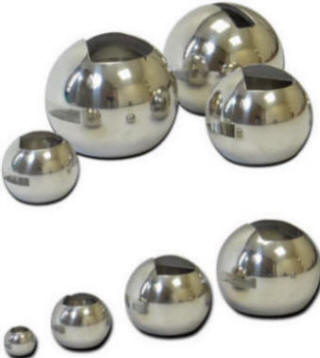Ball Valves for Flow Control
 Standard ball valves are designed to control flow
with a ¼ turn of the ball to either be opened or closed.
Attempting to control pressure drop or flow rate by actuating the ball less
than 90º is really not practical if repeatable accuracy is desired.
To accomplish accurate flow control performance requires modification of a
standard diverting ball.
Standard ball valves are designed to control flow
with a ¼ turn of the ball to either be opened or closed.
Attempting to control pressure drop or flow rate by actuating the ball less
than 90º is really not practical if repeatable accuracy is desired.
To accomplish accurate flow control performance requires modification of a
standard diverting ball.
Ball valves for on and off service have an internal ball having a hole through it, the internal diameter (ID) of this hole either matches the corresponding pipe ID (full port valve) or its ID is slightly smaller (standard or reduced port ball valve). With a ¼ turn (90º) the "sides" of the ball block the inlet and outlet port and thus flow cannot pass through the valve. The inherent problem with using a regular ball valve for a measured flow restriction has to do with the disproportionality of the ball hole with the position of the position of the ball; for example, actuating the ball 45º (half-way between full open and full closed) does not equate to 50% open area (its actually something greater than 50%).
Valves for flow control have a ball opening modified from a straight hole to a slotted style, which can vary in shape depending upon the control characteristics required, the position of the ball can correspond with the degree of actuation, enabling precise flow control. Very often when such precise control is required, pneumatic or electric actuators are utilized as they can respond automatically when interfaced with a PLC system.
Our ball type flow control valves differ from other designs because we utilize a solid ball and not an insert; this enables us to handle higher flow capacities and provide matched ball and stem connections. In particular our control valve ball design reduces differential pressure drop across the valve when compared to globe style control valves.
Valves for flow control are most accurate within the 65º - 75º actuation range and thus the "trick" to properly sizing a control valve is to maximize the valve positioners operational range.
Linear flow characteristics are achieved with slotted ball designs and percentage actuated equivalent flow characteristics are achieved with triangular shaped openings in the balls.
How To Size Control Valves
-
Compute the required Flow Coefficient (Cv)
-
Choose a flow control ball valve which has a Cv at least 20% higher than the required Cv when full open.
-
Select the smallest valve which will provide the targeted Cv, otherwise the operational range of your actuator will be limited.
-
Select the largest actuator feasible for the valve size chosen because this will translate into increased accuracy of the valve positioner.
When dealing with fluids other than water and temperatures other than 60ºF calculations need to be applied to determine the Cv which is based upon water at 60ºF.
The Cv factor is the primary factor used in comparing control valves and thus its to our our advantage when our design translates into a larger Cv for a given size valve.
Design Criteria for Control Valves
-
Description of the liquid, gas or steam, including:
-
The specific gravity (sg)
-
Temperature
-
Vapor and critical pressure
-
-
Specify the desired Cv for a given flow rate
-
Provide the flow rate range
-
Specify the operating (inlet) pressure and required outlet pressure (we can calculate the required Cv)
-
Inlet and outlet pipe size
One Piece Control Valves:
-
PERFORMANCE, up to 12" sizes, Trunnion design for dirty fluids
-
KOMPACT, Wafer style ball valve up to 6" size
Two Piece Control Valves:
-
CONTROL SET, up to 2", threaded, 316SS
-
EZ, up to 14", flanged in either standard or full port designs
-
TITAN, up to 2" size for high pressures and special material requirements such as low temperature carbon steel.
-
TRI-PRO, Up to 4" sizes for connection type flexibility and additional alloy materials of construction such as Alloy 20.
Our valves for flow control inquiry form prompts you for the minimum information required to select the most appropriate valve or valves given your design criteria. Its mush easier and quicker for you to complete the form and have us cross-reference your design criteria against the various valve designs we offer than it is for you to learn about all our valves and make that selection on your own.
We usually reply the same day an inquiry is received or by the next business day.




